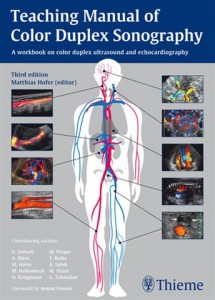|
|
В начало ► Книги по разделам ► Ультрасонография |
|
|
|
|
Color
duplex sonography.
Hofer Matthies
|
|
Hofer Matthies, ed. Teaching Manual of Color Duplex Sonography: A Workbook on Color Duplex Ultrasound and Echocardiography, 3rd ed. Thieme 2011, 120 pages, 500 illustrations,
This introductory text of the clinical applications of Doppler ultrasound, The Teaching Manual of Color Duplex Sonography is an interdisciplinary text meant for both radiologists and sonographers. It is written by a diverse group of German physicians including neurologists, nephrologists, a pediatric cardiologist and radiologists. It is well illustrated with over 400 illustrations. Many of the ultrasound images are paired with a black and white labeled drawing to help the reader understand the anatomy and findings. The organization of the book is excellent with color tabs to find each chapter. The chapters first review anatomy, then suggestions for good image acquisition, normal findings and finally pathologic findings. Each chapter ends with a quiz covering both clinical problems as well as the fundamental principles discussed. The first chapter gives a brief overview of the basic physics behind Doppler ultrasound with a great summary of spectral waveform interpretation. The last chapter gives a summary of recent innovations in diagnostic ultrasound including tissue harmonics and ultrasound contrast. The other chapters are organized by body system. Chapters 2 and 3 are of particular interest to neuroradiologists. Chapter 2 is 10 pages in length and serves as a brief introduction to cerebrovascular imaging. Chapter 3 covers imaging of cervical lymph nodes as well as thyroid ultrasound. While discussing cervical lymph nodes, tables and images are given showing the features which could separate lymph nodes involved by lymphoma versus metastatic disease or from lymphadenitis. However, no statements are made regarding the specificity of these findings leaving the reader to wonder the clinical utility of such trying to differentiate these lymph nodes based on ultrasound features alone. There are some mistakes. For example, in the cerebrovascular chapter, a legend states an arrow is pointing to diastole while it is in fact pointing to peak systole. In the nephrology chapter, a conclusion meant for after the discussion of the role of Doppler imagining in renal artery stenosis is out of order, appearing after the sections on testicular applications. As is expected of a 109-page text which attempts to cover Doppler ultrasound applications in such diverse fields it is often too brief and, at times, incomplete. The evidence-based foundation of principles discussed from the literature is often absent. Additionally, there are advertisements present in the book, one full page ad for Siemens and for Aloka. The authors acknowledge that some of the funding for the book was provided by these industrial partners. Overall, this book is well written, concise, well illustrated and easy to understand. The shortcomings mainly come from its attempt to cover such a broad array of topics in just over 100 pages. This book is recommended mainly for residents and technologists who want an overview of the many clinical applications of color Doppler. |


